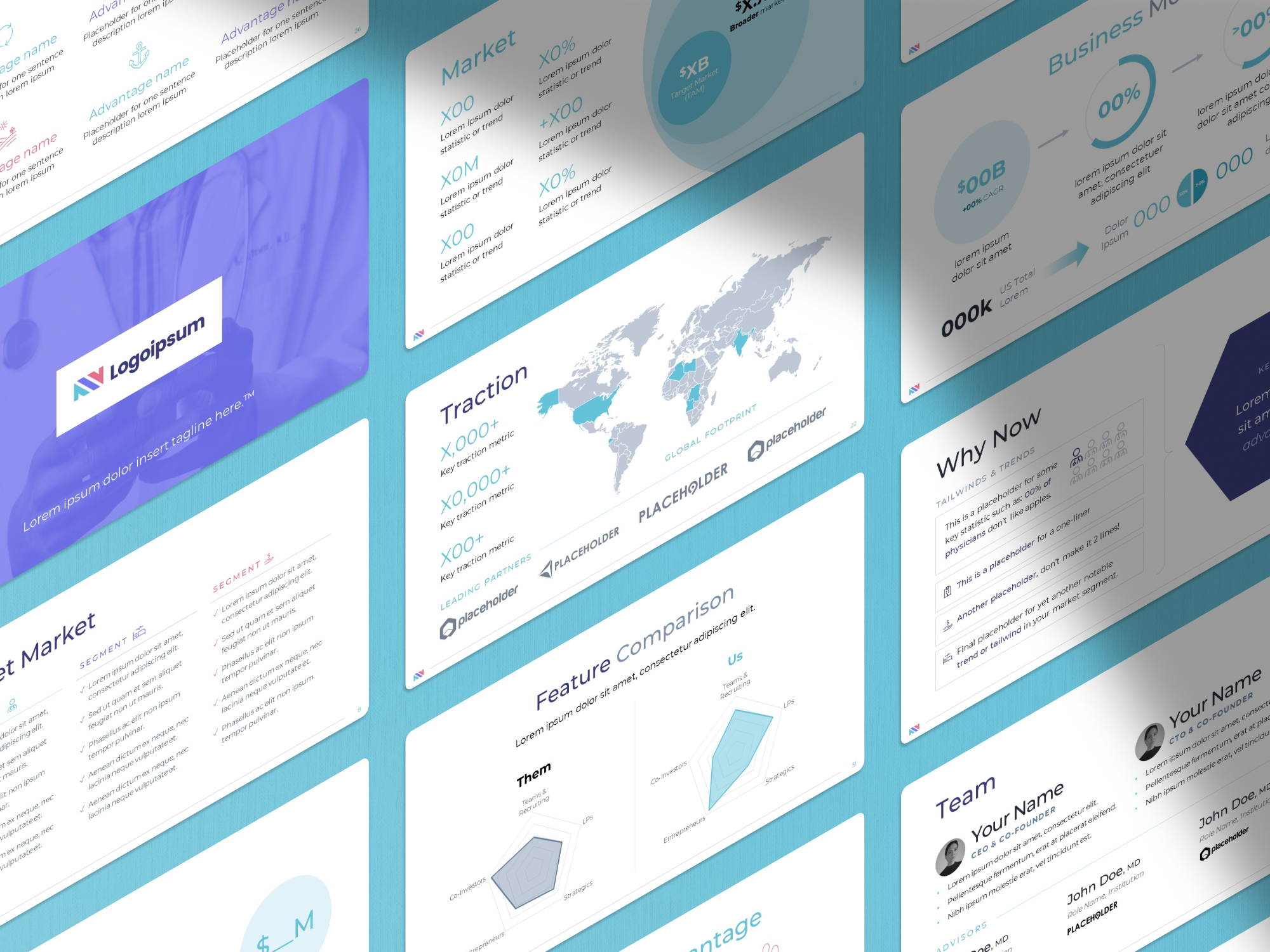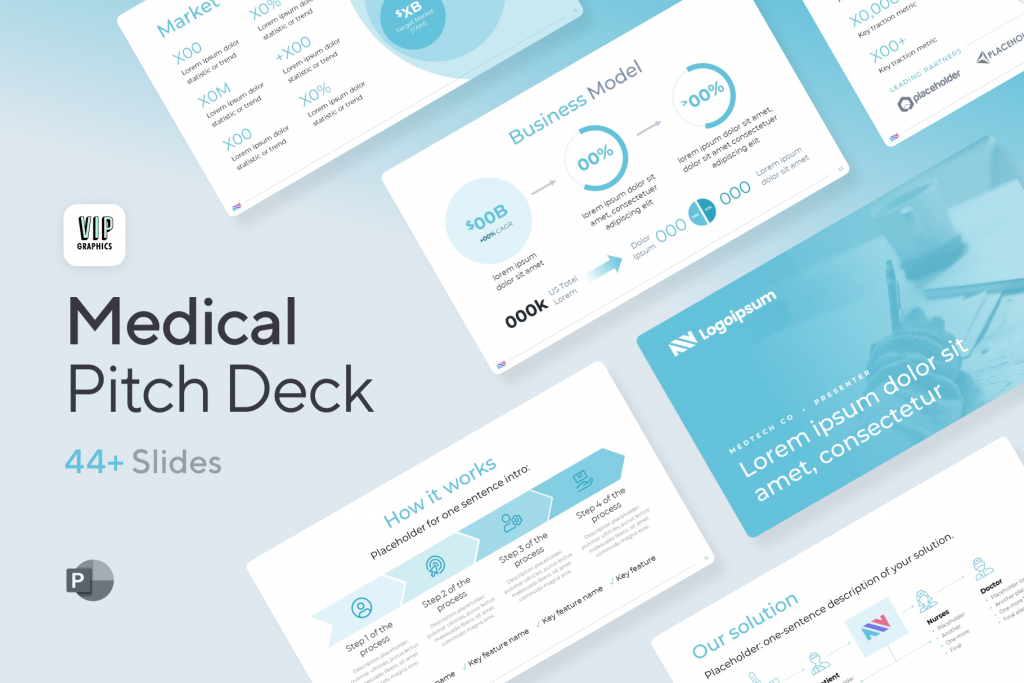As you set out to bring your medical products or services to market, it’s crucial to create an effective pitch deck that effectively communicates your vision to potential investors and partners. Unlike software products, medical startups require significant R&D funding and must navigate complex regulatory timelines.
Crafting a compelling medical pitch deck is a delicate balancing act. Founders who come from academic backgrounds may find it difficult to avoid scientific jargon and communicate in investor-friendly terms. This article will explore the essential elements of a winning pitch deck that will captivate your audience and secure the funding your revolutionary medical startup deserves.
What is a pitch deck? Why do medical startups need a pitch deck?
Pitch decks are an essential tool for founders launching a new business or startup, generally used for pitching investors (as well as presenting to retailers and partners, in some industries). Most pitch decks come in the form of a 10 – 15 slide presentation, though some companies have explored alternative formats (ie. Rippling’s investment memo).
From medical devices and new pharmaceutical drugs to healthcare management software & services, startups across the medical industry require considerable capital investment for R&D before they are ready to go-to-market. Building a winning pitch deck is critical to the success of these businesses in winning deals & funding from investors, grants, and commercial partners.
The core objective of a pitch deck is to persuade investors of the technological promise and commercial feasibility of your medical product(s) or service(s). A well-crafted pitch deck should concisely describe your solution, project milestones and why investors should invest in your company.
What slides should a medical pitch deck include?
Crafting a successful medical pitch deck is no small feat: striking the perfect balance of scientific detail and market analysis can be challenging. This guide will walk you through the recipe for building an effective pitch deck: from creating eye-catching visuals that bring your vision to life, to ensuring every slide is concise and compelling:
1. Cover Slide
The first slide of a pitch deck is a crucial opportunity for medical startup founders to showcase what sets their company apart. It should offer investors a glimpse into the unique qualities of the product or service being offered, and leave a lasting impression that will extend far beyond the initial meeting. To maximize impact, the cover slide should be visually compelling, featuring eye-catching product imagery and the company logo. Additionally, including social proof in the form of a grid of notable partner logos can help pique investor interest. Remember, this first impression is key – founders only have one shot to capture investors’ attention and make a strong case for why they should invest in the company.
2. Opportunity Slide
Many medical companies won’t have a problem slide in their pitch deck since they may solve a fairly obvious problem (i.e., cancer, viruses). Instead, most medical pitch decks will include opportunity slide that speaks directly to how the product addresses an unmet need. In addition to highlighting the problem, this slide should speak to specific pain points and the scale of the opportunity (ie. $XM spent annually on cancer treatments).
3. Solution Slide
Having introduced an unmet need or shortcoming of the existing “standard of care” in the previous slide, the solution slide of the pitch deck introduces how your startup solves this problem. While it is important to highlight how your solution overcomes significant medical or biological challenges, investors will be most interested in the market opportunity and differentiators.
4. How It Works Slide
Visually demonstrating the functionality of your solution or product is essential in maximizing the impact of a medical startup’s pitch deck. Utilizing infographics and flowcharts to elucidate complex information is an effective method of ensuring that investors (even those without technical backgrounds) comprehend the mechanism behind your medical product or service. Avoiding jargon and instead using visuals to demonstrate the mechanism of action behind the solution is critical to communicate effectively with all audiences. Although supporting research should be included to emphasize the efficacy of the innovation, the deck should not overwhelm the audience with incomprehensible charts and academic papers.
5. Competitive Advantage Slide
The advantage slide is a crucial aspect of any pitch deck: it should showcase your solution’s unique selling proposition (USP) and demonstrate why it is the best solution to the given problem. Highlight pain points that competitors and incumbents fail to solve and explain how your solution succeeds where they fall short. This slide should also include data or research that supports your company’s claims of differentiation. Essentially, it should help investors understand the “moat” and “secret sauce” that differentiate your company from others.
6. Market Slide
The market slide should showcase the startup founders’ in-depth comprehension of the demand for their solutions. In addition to assessing the total market size and growth, this slide should incorporate data on the target market and the unmet needs that the unique technology can address. By providing a clear view of the total addressable market (TAM) and strategic insights on how to capitalize on emerging opportunities, this slide allows investors to envision the startup’s potential to become a billion-dollar “unicorn” in their portfolio.
7. Applications Slide
The applications slide should showcase the tangible benefits that your product or service offers, such as the conditions or diseases that it can treat, the types of research that require your reagents or services, and the intended results. It is important to convey to investors that your product or service has broad applications in growing industries, which translates to a large addressable market.
8. Traction Slide
The traction slide is a snapshot of your startup’s progress and success to date. It should display milestones such as patents filed or granted, clinical trial stages, logos of notable partners and strategic collaborations, grants awarded, and other significant achievements. These de-risking factors, including traction, intellectual property (IP), and marquee partners, are essential to investors and directly impact the funding valuation they are willing to commit to your startup.
9. Clinical Pipeline / Roadmap Slide
Any pitch deck is incomplete without discussing the startup’s future prospects. For medical pitch decks, the clinical pipeline slide is the best representation of the startup’s roadmap and expected growth trajectory. The slide generally presents the company’s plan for commercialization through a Gantt chart of clinical trial phases, starting from the preclinical stage and leading up to regulatory approval.
10. Team Slide
11. Investment Slide
The investment slide in your presentation should provide detailed information on your company’s request for capital and the associated terms of investment. This slide can also feature notable investors and business partners who have already committed to your company. Some presentations may include a detailed ask with terms, use of funds, and cap tables, while others may simply state the capital goals, associated milestones, and plan for the next raise (a-la-Y-Combinator’s recipe).
12. Vision Slide
Investors will be interested in your medical startup’s broader vision beyond the clinical roadmap. While the clinical pipeline slide focuses on product development, this slide should outline the go-to-market and growth strategy, as well as the overall mission. A comprehensive vision should include the company’s plans for expanding the total addressable market (TAM) and the potential for alternative uses or indications of the technology.
13. Call-to-Action Slide
The key to winning deals quickly (for any pitch: investment, or otherwise) is concluding with a clear call to action. Always provide one point-of-contact and definitive next steps for investors who want to learn more. Your CTA slide should empower investors to move forward if they are interested.
Tips for designing the perfect medical pitch deck
Investors see thousands of presentations every year: elevate your medical startup’s pitch deck to stand out from the competition by following these tips. Employ these simple strategies for crafting an impactful presentation that successfully conveys the value proposition of your company to investors – while leaving them wanting more!
- Use infographics & flowcharts: Visual representations of complex ideas make it easier to communicate your plans. Avoid using technical jargon and charts from research papers that can be difficult for investors to understand.
- Utilize analogies and visuals: Simplify technical concepts for layperson audiences by using analogies and visuals that investors can relate to. If investors can visually understand the benefits or mechanism of your technology, you can skip much of the technical background and jargon that will bore them.
- Focus on the market & opportunity: Investors are interested in the market opportunity and the potential for a return on their investment. Demonstrate how big the market is and explain why your solution is highly sought-after. Don’t spend too much time on how your technology works on a technical level.
- Keep it concise: Finally, a medical pitch deck should be succinct and direct to the point. Investors have limited attention spans, so it’s essential to get your message across quickly and effectively.
Need help creating your medical pitch deck?
Creating a compelling pitch deck will help your medical startup secure funding from investors & grants and deals with partners and potential customers! To make your life easier, you may be interested in the Medical Pitch Deck Template, built specifically to help startups in the medical space: from telemedicine apps and healthtech startups, to pharma services and practice management software. Easily create a professional-grade investor presentation for your medical startup — check it out here.

